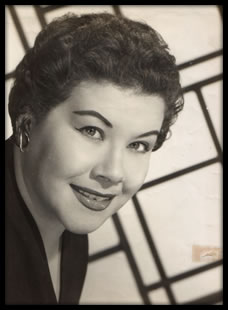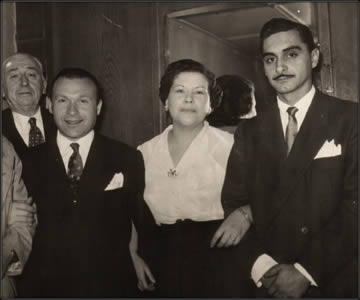By
Miranda - Talking to Nina Miranda, at her place

called her by phone fearing that she would not be interested. Some friend of mine had warned me that she did not like interviews and that she didn’t care to talk about her career. But this time it was quite the opposite. I turned up, introduced myself, and told her about the admiration we had for her, and of the importance that her testimony would represent for Todo Tango. She soon agreed and invited me to her house in Floresta Norte. There we went, my friend Néstor Pinsón and I, plus a tape recorder and a hundred questions to ask her.
 To chat with Nina, according to me, the best female singer born in Uruguay, was a real privilege. This lady, in the 50s, through her singing cast a spell on the two banks of the River Plate.
To chat with Nina, according to me, the best female singer born in Uruguay, was a real privilege. This lady, in the 50s, through her singing cast a spell on the two banks of the River Plate.
Owner of a natural way of voice production, a crystalline voice, and an expressive soft phrasing, unfortunately, she was never accompanied with the musical level she deserved. However, her recordings have the charm of her finesse, of her perfect intonation, of a promising personality. Fresh, spontaneous, a brunette with striking blue eyes, she possessed all those in-born features, all that which is learnt in no academy. You have it or you don’t have it.
Unfortunately, on her husband’s request, she quit her singing career and so was frustrated what could have become the great tango star of the mid- years of the twentieth century
«I always liked singing. Please hear this story: mom was a fervent catholic, a devout of the Holy Heart of Jesus and always went to church. One day when we were in church, I was only three years old, all of a sudden I began to sing “Pato, te peinás a la gomina....”, but I was immediately shut up. Of course, at home we listened to the radio very much and tango was ever present and evidently that song had caught me.
«Mom liked Irusta and Ignacio Corsini, besides Gardel and Mercedes Simone. She also liked Spanish music and Imperio Argentina.
«My parents used to move from place to place very often, but I spent my teen years at the same house in the neighborhood Cerrito de la Victoria, on 3463 Bruno Méndez Street. Once when I was singing while watering the garden, the father of a schoolmate girl passed by. He was an actor and played at soap operas on radio. Then he told me: “So it was you the one who sings. Wasn’t it? You do it well. You have to appear at some contest”. I told him I was very young.
«Much later a similar episode happened again. I clearly recall I was singing the waltz written by Salgán and Carmelo Volpe “A una mujer” (here Nina softly sings some of its lines). Then the same man turned up but this time I accepted. I went there and I won the contest organized by the Dante Brothers which was aired as radio broadcasts. The days I had to perform Daddy woke me up early and then he accompanied me to the show’s place. ¡Ah! I was already Nina Miranda.
«When I was 13 I went to the movie theater with Mom to see “Puerta cerrada”, a film which starred Libertad Lamarque and Agustín Irusta. She played the role of a female singer whose name was Nina Miranda. When we went out I firmly told my mother: “The day I’m an artist I shall use that name”.
«Thereafter in 1942, I won another contest on CX 36 Radio Centenario. The award was a three-month contract. Someone heard me and sent me a proposal to sing in an all-ladies orchestra which performed in many venues. It was called “Las Golondrinas” and was led by Teresita Añón. We had a popular songbook with tangos, milongas and waltzes. We soon made a tour of the south of Brazil, up to Porto Alegre. Time later, another to San Pablo, where we had a six-month tenure at the boite Okey which still today exists. In Montevideo we appeared at the Café Palace which was located under the Palacio Salvo, where all-ladies orchestras always played.
«Later I passed through the ranks of several aggregations. I was with Francisco Reinares, Emilio Pellejero, Roberto Lurati, but I never recorded with them. My first recordings were with Juan Cao. Then I sang in duo with Alberto Bianchi, much older than I. He helped me a lot. I was beginning to be known and, in 1948, I appeared for a season at a show in the Hotel Rambla, with the orchestra led by Pellejero. My name was at the billboard along with Eduardo Adrián’s, a charming person.

«How did I join the Donato Racciatti Orchestra? It was 1952 and I was angry at my mother’s death and felt like leaving. I came to know that my Uruguayan colleague Roberto Famá was about to make a tour of Brazil. Then I gathered some clippings that were published about me with the intention that he may get something for me at that country. As I knew that he was recording at Sondor, I went to fetch him. While I was waiting the orchestra leader Juan Esteban Martínez, “Pirincho”, went out from a studio. He was surprised when he saw me and told me: “Hey, Negra, you’ve come just in time, here’s a woman that someone sent but she’s at a loss... Would you dare to sing “Maula”?” I told him I had never sung it. “It doesn’t matter. You have a terrific ear! You have to learn the music and sing it with the lyrics in front of you”. In fact, in 40 minutes I recorded it.
«It was a hit. It was aired everyday on all the radio stations, several times. Because of the record success Racciatti called me to appear at the one-act farce “Tu cuna fue un conventillo” at the Teatro 18 de Julio. The play was to be staged for a month but the tenure lasted six months. It was quite a boom for me. Here I sang “Maula” and premiered “Tu corazón”. Later came the recordings. I chose my repertoire, save for “De tardecita” which was suggested by Racciatti but I was not convinced. It turned out another hit.
«With “Mano a mano” came the idea of making an addition to the lyrics so that a woman would be able to answer back to a man. Humberto Correa, the author of “Mi vieja viola”, handled that. I recorded it with the singer Roberto Lister but at the recording company a mistake was made and on the record label Carlos Roldán and Olga Delgrossi were mentioned. We are very close friends with Olguita and she told me that a thousand times she had to say that she was not the singer on that record.
«In Montevideo with Carlitos Roldán I recorded a number dedicated to soccer: “Los dos grandes”, which alluded to the Club Nacional, my team, and to Peñarol. As well for the movies I dubbed an Uruguayan motion picture in which I didn’t appear even though the casting said: “Vocals in the songs: Nina Miranda”. In Argentina I recorded the tango “La tigra”, but in the movie with the same title, María Esther Casas dubs the voice of the actress Diana Maggi.
«In 1955 I came to Buenos Aires to enhance my artistic horizons. By that time the journalist Augusto Bonardo, who already was exiled in Montevideo, was the director of Radio El Espectador and helped me with connections for my voyage.
«I arrived in August, via Sao Paulo, because the Argentine government had closed the borders with Uruguay. Radio Belgrano and the Odeon label hired me. The first thing I did was to record 14 pieces with an orchestra led by Graciano Gómez. On radio, for three months, I appeared on Mondays and Wednesdays with the Lucio Demare Orchestra. Soon later Perón was ousted, the borders were opened and I began to go and return by plane to appear on Radio El Espectador with the sextet led by Oldimar Cáceres.

«I split with Graciano Gómez after a tour throughout the north of Argentina. We only arrived at Salta because of billboard problems. Later I made another tour but with the orchestra led by Héctor Norton.
«Thereafter I continued until 1958 with my own ensemble led by Fernando Córdoba. With the latter I made my last recordings. I had already decided to retire. In fact, it was a decision of my husband. I married him on October 11, 1957 and he did not like that I went on singing: “What for? You’ll have everything.” I was much in love.
«I wrote a lyric dedicated to my husband titled “No importa lo que digan”. I went to see Néstor D’Alessandro with it. He as well had an instrumental tango to be premiered titled “No hagas caso de la gente”. The lyrics were suitable for the music and it remained with the title suggested by D’Alessandro. I also composed the tango “Canción para mi amor”, that a musician of the Editorial Korn’s staff transcribed into written music. It has lyrics by Abel Aznar and was recorded by the Colombian star Mirta Pérez.
«I’m all right, it’s over forty years I don’t sing any more.» But she confesses to us that she is vocalizing with Héctor De Rosas because there’s a project, in Uruguay, to record along with Olga Delgrossi and Oscar Nelson. «If I think I’m in good shape I’ll agree.»
«Among female singers I liked Mercedes Simone and Libertad Lamarque. I never liked Azucena Maizani.
«In 1999 there was an homage to Racciatti in Uruguay and when I was mentioned the audience stood up and started to ask that I had to sing. It was at the Teatro del SODRE. I was with my husband who told me “Stand up and say something”. I did it, and I apologized, but the audience and Donato insisted so I was forced to step onto the stage. I said I was going to sing an excerpt from “Maula”, but I sang it completely and it was great. I was so touched. Then I really became aware of what I had meant for people.
«Didn’t I tell you that I never studied, that I never made a vocal exercise? Nothing at all, all was natural».